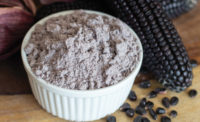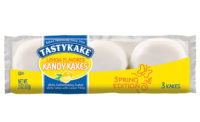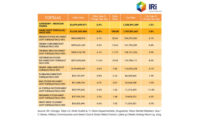Many snack producers are adding interesting flavors and ingredients to their pretzels. Recent product introductions include pretzel nuggets filled with peanut butter and dark chocolate, as well as more gluten-free options. Many are using all-natural, vegan ingredients—including those previously foreign to the segment, such as butternut squash.
Nevertheless, traditional versions of pretzels continue to maintain their popularity. They’re relatively healthy snack options that provide on-the-go convenience. But pretzel developers could see more growth by embracing innovation.
Overview | Chips | Puffed/Extruded Snacks | Popcorn | Snack Mixes & Nuts | Tortilla Chips | Pretzels | Frozen Snacks | Crackers
Market data
While the overall salty snacks category saw growth of 4.9 percent to $24.9 billion, the pretzels segment remained largely flat, growing only 0.2 percent to $1.2 billion, per IRI, Chicago, for the 52 weeks ending May 19, 2019. The top company in this segment is Snyder’s-Lance, a Campbell Soup Co. subsidiary, which had $451.3 million in sales for the year, a 2.2 percent decline. Its major pretzel brand, Snyder’s of Hanover, racked up $420.7 million in sales, but likewise saw a decline, off 2.3 percent. Its Snyder’s of Hanover 100 Calorie Pack line grew 7.2 percent to $24.7 million.
Utz Quality Foods is the only top five company that saw growth for the year, up 8.2 percent to $109.8 million. Its core Utz brand grew 10.0 percent to $87.5 million, while its Utz Specials brand grew 2.6 percent to $16.5 million.
One standout performer is Dot’s Homestyle Pretzels, which had a third consecutive year of over 100 percent growth. For the current reporting period, the company saw its sales increase 109.0 percent. Dot’s is now a $37.3 million brand.
Unique Pretzel Bakery saw another year of growth for its Unique Splits brand, up 12.1 percent to $10.1 million, while its Unique Shells brand grew 14.1 percent to $5.0 million.
Detroit’s Better Made Snack Foods had an up year for its pretzels, seeing growth of 5.7 percent to $4.1 million.
Benzel’s Bretzel Bakery, a Pennsylvania pretzel baker for over 100 years, continues to make headway with its Pennysticks brand, up 14.6 percent to $3.8 million.
Pretzels also come into play in the chocolate covered salted snack segment of the “other snacks” category. Segment leader Flipz, a chocolate-covered pretzel brand from pladis Global, grew 4.3 percent to $65.0 million. The brand recently released Flipz Mix, a combination of milk chocolate-covered pretzels, popcorn, plain pretzels and candy-coated chocolate pieces. The Hershey Co. is also seeing growth of its snack mix products. Hershey’s Snack Mix, which combines mini Hershey’s chocolate bars, pretzels and almonds, grew 101.3 percent to $27.7 million. The Reese’s product, combining mini Reese’s peanut butter cups, Reese’s Pieces, pretzels and peanuts, grew 95.9 percent to $26.6 million.
Looking back
Several factors are driving growth in the pretzel market: increasing demand for convenience foods, the continued popularity of snacking and consumer preference for healthier snacks. Common pretzel accents include salt, peanut butter and chocolate.
This past year, Quinn Snacks launched Gluten-Free Peanut Butter Filled Pretzel Nuggets and Dark Chocolate’y Peanut Butter Filled Pretzel Nuggets. They’re the latest additions to the company’s line of natural, gluten-free, non-GMO pretzels made with sorghum.
Justin Spannuth, vice president and chief operations officer, Unique Pretzel Bakery, Reading, PA, notes that gluten-free is a primary area of innovation for pretzels today. “There are a few alternative flours on the rise. It will be interesting to see what the next trend in ingredients will turn out to be.”
Sourdough is also a sweet spot for pretzels. Unique Pretzel Bakery’s most-recent launch was targeted at the sourdough pretzel space—and the company hopes to find alignment with the craft beer market. “Our Sourdough Craft Beer Pretzel Rings are a high-end sourdough,” says Spannuth. “They aren’t too thick, not too hard. They are made with malted barley and hops, in a ring shape that fits around the neck of a beer bottle. They are easy to hold, and easier to bite than a typical sourdough.”
Pretzels recently have gained some momentum because they’re considered by many to be healthier than other snack options, while still providing on-the-go convenience, says Stephanie Lynch, vice president of sales, marketing and technology, International Dehydrated Foods Inc., Springfield, MO. “The health halo is likely due to the low-fat content and nutrients contributed through fortified flour. According to recent research, brands that highlight the health attributes of their products appeal to increasingly health-conscious consumers.”
Vegetables continue to show up in interesting places. This past year, REAL FOOD FROM THE GROUND UP launched a Butternut Squash Pretzels in sticks and twists. The company also makes crackers and tortilla chips from a cauliflower substrate.
Looking forward
In order to increase market share, pretzels need to taste amazing without losing their clean-label appeal, says Gregg Latterman, co-founder and co-CEO of the upstart Positive Pretzels, Chicago. This is because more consumers are looking for clean and simple ingredients in highly craveable snacks. “Consumers have more choices in the better-for-you snack category, and they’re looking for snacks that have high-quality ingredients without sacrificing on taste,” he says. Positive Pretzels, which launched this past year, are available in three flavors: Sea Salt, Honey and Jalapeño, all made with organic flour and organic sunflower oil.
New flavors that make pretzels more craveable are the future, notes Latterman. “Meal skipping, especially lunch, is now commonplace. Pretzels are the perfect snack to help bridge the gap between breakfast and dinner,” he suggests.
Pretzels are also well-positioned to bring more better-for-you attributes to snacking occasions. Looking ahead, snack producers who want to differentiate their pretzel products should consider fortifying them with protein, suggests Lynch, noting that her company’s Chicken Protein Isolate Powder is made from all-natural chicken, a versatile and diet-friendly protein. “CHiKPRO is free from common allergens, including soy, whey and gluten, and aligns with trending diets. Also, its savoriness may allow formulators to reduce the sodium content in their pretzel applications.”
Spannuth predicts that innovations in pretzel products will continue for years to come, noting that capturing the attention of specific audiences and breaking down the masses is the key. “When we launch a new pretzel product, it is a specialty item and directed at a consumer demographic that we don’t currently serve.” Also, he adds, working with suppliers that provide the best ingredient traceability practices will ultimately win business of the future.
Overview | Chips | Puffed/Extruded Snacks | Popcorn | Snack Mixes & Nuts | Tortilla Chips | Pretzels | Frozen Snacks | Crackers









